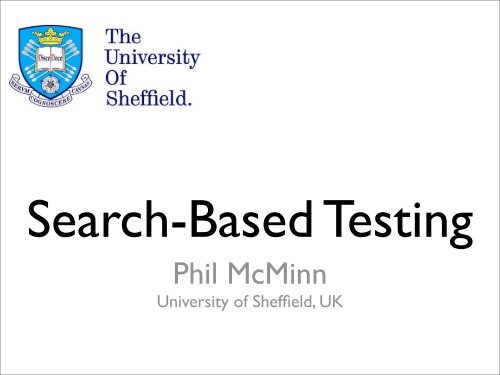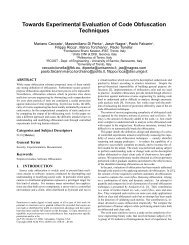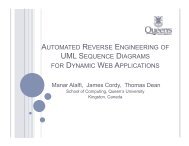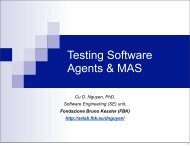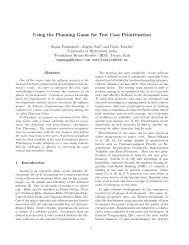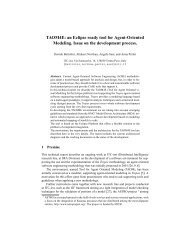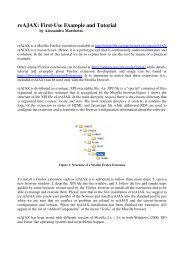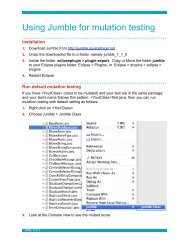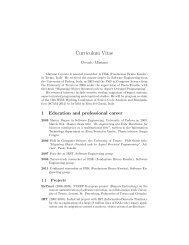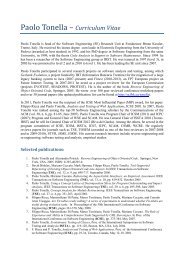slides available - FBK | SE
slides available - FBK | SE
slides available - FBK | SE
- No tags were found...
You also want an ePaper? Increase the reach of your titles
YUMPU automatically turns print PDFs into web optimized ePapers that Google loves.
Search-Based Testing<br />
Phil McMinn<br />
University of Sheffield, UK
Overview<br />
How and why Search-Based Testing Works<br />
Examples<br />
Temporal, Functional, Structural<br />
Applications in Mutation Testing<br />
Test suite prioritisation<br />
Search-Based Test Data Generation<br />
Testability Transformation<br />
Input Domain Reduction<br />
Empirical and Theoretical Studies<br />
Future Directions
Acknowledgements<br />
The material in some of these <strong>slides</strong> has kindly<br />
been provided by:<br />
Mark Harman (KCL/UCL)<br />
Joachim Wegener (Berner & Matner)
Conventional Testing<br />
manual design of test cases / scenarios
Conventional Testing<br />
manual design of test cases / scenarios<br />
laborious,<br />
time-consuming
Conventional Testing<br />
manual design of test cases / scenarios<br />
laborious,<br />
time-consuming<br />
tedious
Conventional Testing<br />
manual design of test cases / scenarios<br />
tedious<br />
laborious,<br />
time-consuming<br />
difficult!<br />
(where are the faults )
Conventional Testing<br />
manual design of test cases / scenarios<br />
tedious<br />
laborious,<br />
time-consuming<br />
difficult!<br />
(where are the faults )<br />
the hard part...
Random Test Data<br />
Generation<br />
Input
Random Test Data<br />
Generation<br />
Input
Random Test Data<br />
Generation<br />
Input
Search-Based Testing is an<br />
automated search of a<br />
potentially large input space<br />
the search is guided by a<br />
problem-specific ‘fitness function’
Search-Based Testing is an<br />
automated search of a<br />
potentially large input space<br />
the search is guided by a<br />
problem-specific ‘fitness function’<br />
the fitness function guides the search<br />
to the test goal
Fitness Function<br />
The fitness function scores different inputs<br />
to the system according to the test goal
Fitness Function<br />
The fitness function scores different inputs<br />
to the system according to the test goal<br />
which ones are ‘good’<br />
(that we should develop/evolve further)
Fitness Function<br />
The fitness function scores different inputs<br />
to the system according to the test goal<br />
which ones are ‘good’<br />
(that we should develop/evolve further)<br />
<br />
which ones are useless<br />
(that we can forget about)
Fitness-guided search<br />
Fitness<br />
Input
Fitness-guided search<br />
Fitness<br />
Input
Fitness-guided search<br />
Fitness<br />
Input
First publication on SBST<br />
Automatic Generation of Floating-Point Test Data<br />
IEEE Transactions on Software Engineering, 1976<br />
Webb Miller<br />
David Spooner<br />
Winner of the 2009 Accomplishment by a Senior Scientist Award<br />
of the International Society for Computational Biology<br />
2009 Time100<br />
Scientists and Thinkers
Publications since 1976<br />
source: <strong>SE</strong>BA<strong>SE</strong> publications repository http://www.sebase.org
International Search-Based Testing<br />
Workshop<br />
co-located with ICST<br />
4th event at ICST 2011<br />
next year<br />
check websites for<br />
submission deadlines etc.:<br />
http://sites.google.com/site/icst2011/<br />
http://sites.google.com/site/icst2011workshops/
International Symposium on<br />
Search-Based Software<br />
Engineering<br />
www.ssbse.org<br />
Benevento, Italy.<br />
7th - 9th September 2010
International Symposium on<br />
Search-Based Software Engineering<br />
www.ssbse.org<br />
2011: Co-location with F<strong>SE</strong>.<br />
Szeged, Hungary<br />
Phil McMinn<br />
General Chair<br />
Myra Cohen and Mel Ó Cinnéide<br />
Program Chairs
Fitness Functions<br />
Often easy<br />
We often define metrics<br />
Need not be complex
Daimler Temporal Testing<br />
deceleration<br />
optimal point<br />
in time for<br />
triggering the<br />
airbag igniter<br />
Fitness = duration<br />
t min<br />
t<br />
t max
J. Wegener and M. Grochtmann. Verifying timing constraints of<br />
real-time systems by means of evolutionary testing. Real-Time<br />
Systems, 15(3):275– 298, 1998.
Conventional testing<br />
manual design of test cases / scenarios<br />
laborious,<br />
time-consuming<br />
tedious<br />
difficult!<br />
(where are the faults )
Conventional testing<br />
manual design of test cases / scenarios<br />
laborious,<br />
time-consuming<br />
tedious<br />
difficult!<br />
(where are the faults )<br />
Search-Based Testing:<br />
automatic - may sometimes be<br />
time consuming, but it is not a<br />
human’s time being consumed
Conventional testing<br />
manual design of test cases / scenarios<br />
laborious,<br />
time-consuming<br />
tedious<br />
difficult!<br />
(where are the faults )<br />
Search-Based Testing:<br />
Search-Based Testing:<br />
automatic - may sometimes be<br />
time consuming, but it is not a<br />
human’s time being consumed<br />
a good fitness function<br />
will lead the search to<br />
the faults
Generating vs Checking<br />
Conventional Software Testing Research<br />
Write a method to construct test cases<br />
Search-Based Testing<br />
Write a method<br />
to determine how good a test case is
Generating vs Checking<br />
Conventional Software Testing Research<br />
Write a method to construct test cases<br />
Search-Based Testing<br />
Write a fitness function<br />
to determine how good a test case is
Daimler Autonomous<br />
Parking System<br />
Input<br />
psi<br />
gap<br />
dist2space<br />
space width<br />
space length
Daimler Autonomous<br />
Parking System<br />
Fitness
Generation 0
Generation 0 Generation 10<br />
critical
Generation 0 Generation 10<br />
critical<br />
collision<br />
Generation 20
Test setup<br />
Usual approach to testing<br />
Manually generated input situations<br />
Simulation<br />
environment<br />
Software<br />
under test<br />
Output of test
Test setup<br />
Search-Based Testing approach<br />
Automatically generated inputs<br />
Search<br />
Algorithm<br />
Simulation<br />
environment<br />
Software<br />
under test<br />
Feedback loop<br />
outputs (converted to fitness values)
O Bühler and J Wegener: Evolutionary functional testing, Computers & Operations Research,<br />
2008 - Elsevier<br />
O. Buehler and J. Wegener. Evolutionary functional testing of an automated parking system. In<br />
International Conference on Computer, Communication and Control Technologies and The<br />
9th. International Conference on Information Systems Analysis and Synthesis, Orlando,<br />
Florida, USA, 2003.
Structural testing
Structural testing<br />
fitness function analyses<br />
the outcome of<br />
decision statements and the<br />
values of variables in<br />
predicates
Structural testing<br />
fitness function analyses<br />
the outcome of<br />
decision statements and the<br />
values of variables in<br />
predicates<br />
More later ...
Assertion testing
Assertion testing<br />
assertion condition<br />
speed < 150mph
Assertion testing<br />
assertion condition<br />
speed < 150mph<br />
fitness function:<br />
f =150 - speed
Assertion testing<br />
assertion condition<br />
speed < 150mph<br />
fitness function:<br />
f =150 - speed<br />
fitness minimised<br />
If f is zero or less a fault is found
Bogdan Korel, Ali M. Al-Yami: Assertion-Oriented<br />
Automated Test Data Generation. IC<strong>SE</strong>, 1996: pp. 71-80
Search Techniques
Hill Climbing<br />
Fitness<br />
Input
Hill Climbing<br />
Fitness<br />
Input
Hill Climbing<br />
Fitness<br />
Input
Hill Climbing<br />
Fitness<br />
Input
Hill Climbing<br />
Fitness<br />
No better solution in neighbourhood<br />
Stuck at a local optima<br />
Input
Hill Climbing - Restarts<br />
Fitness<br />
Input
Hill Climbing - Restarts<br />
Fitness<br />
Input
Hill Climbing - Restarts<br />
Fitness<br />
Input
Hill Climbing - Restarts<br />
Fitness<br />
Input
Hill Climbing - Restarts<br />
Fitness<br />
Input
Hill Climbing - Restarts<br />
Fitness<br />
Input
Hill Climbing - Restarts<br />
Fitness<br />
Input
Hill Climbing - Restarts<br />
Fitness<br />
Input
Simulated Annealing<br />
Fitness<br />
Input
Simulated Annealing<br />
Fitness<br />
Input
Simulated Annealing<br />
Fitness<br />
Input
Simulated Annealing<br />
Fitness<br />
Input
Simulated Annealing<br />
Fitness<br />
Input
Simulated Annealing<br />
Fitness<br />
Input
Simulated Annealing<br />
Fitness<br />
Worse solutions<br />
temporarily<br />
accepted<br />
Input
Evolutionary Algorithm<br />
Fitness<br />
Input
Evolutionary Algorithm<br />
Fitness<br />
Input
Evolutionary Algorithm<br />
Fitness<br />
Input
Evolutionary Algorithms<br />
inspired by Darwinian Evolution and concept of<br />
survival of the fittest<br />
Crossover<br />
Mutation
Crossover<br />
a b c d<br />
10 10 20 40<br />
a b c d<br />
20 -5 80 80
Crossover<br />
a b c d<br />
10 10 20 40<br />
a b c d<br />
20 -5 80 80
Crossover<br />
a b c d<br />
10 10 20 40<br />
a b c d<br />
20 -5 80 80
Crossover<br />
a b c d<br />
10 10 20 40<br />
a<br />
10<br />
b<br />
10<br />
a b c d<br />
20 -5 80 80<br />
c<br />
d<br />
20 40
Crossover<br />
a b c d<br />
10 10 20 40<br />
a<br />
10<br />
b<br />
10<br />
c<br />
d<br />
80 80<br />
a b c d<br />
20 -5 80 80<br />
a<br />
20<br />
b<br />
-5<br />
c<br />
d<br />
20 40
Mutation<br />
a b c<br />
10 10 20<br />
d<br />
40
Mutation<br />
a b c<br />
d<br />
d<br />
10 10 20 40 20
Mutation<br />
a b c<br />
d<br />
d<br />
10 10 20 40<br />
20
Mutation<br />
a<br />
b c<br />
d<br />
d<br />
20 10 10 20 40<br />
20
Evolutionary Testing
Evolutionary Testing<br />
Insertion<br />
Mutation<br />
Fitness Evaluation<br />
Crossover<br />
End<br />
Selection
Evolutionary Testing<br />
Insertion<br />
Mutation<br />
Test cases<br />
Fitness Evaluation<br />
Crossover<br />
Monitoring<br />
Selection<br />
Execution<br />
End
Which search method<br />
Depends on characteristics of the search landscape
Which search method<br />
Depends on characteristics of the search landscape
Which search method<br />
Depends on characteristics of the search landscape
Which search method<br />
Depends on characteristics of the search landscape
Which search method<br />
Depends on characteristics of the search landscape
Which search method<br />
Some landscapes are<br />
hard for some<br />
searches but easy for<br />
others<br />
...and vice<br />
versa...
Which search method<br />
Some landscapes are<br />
hard for some<br />
searches but easy for<br />
others<br />
...and vice<br />
versa...
Which search method<br />
Some landscapes are<br />
hard for some<br />
searches but easy for<br />
others<br />
...and vice<br />
versa...
Which search method<br />
Some landscapes are<br />
hard for some<br />
searches but easy for<br />
others<br />
...and vice<br />
versa...<br />
more on<br />
this later...
Ingredients for<br />
an optimising search<br />
algorithm<br />
Representation<br />
Neighbourhood<br />
Fitness Function
Ingredients for<br />
Search-Based Testing<br />
Representation<br />
Neighbourhood<br />
Fitness Function
Ingredients for<br />
Search-Based Testing<br />
Representation<br />
Neighbourhood<br />
Fitness Function<br />
A method of encoding all possible inputs<br />
Usually straightforward<br />
Inputs are already in data structures
Ingredients for<br />
Search-Based Testing<br />
Representation<br />
Neighbourhood<br />
Part of our understanding of the problem<br />
We need to know our near neighbours<br />
Fitness Function
Ingredients for<br />
Search-Based Testing<br />
Representation<br />
Neighbourhood<br />
Fitness Function<br />
Transformation of the test goal to a<br />
numerical function<br />
Numerical values indicate how ‘good’ an<br />
input is
More search algorithms
More search algorithms<br />
Tabu Search<br />
Particle Swarm Optimisation<br />
Ant Colony Optimisation<br />
Genetic Programming<br />
Estimation of Distribution Algorithms
SBST Surveys & Reviews<br />
Phil McMinn: Search-based software test data generation: a survey. Software Testing, Verification and<br />
Reliability 14(2): 105-156, 2004<br />
Wasif Afzal, Richard Torkar and Robert Feldt: A Systematic Review of Search-based Testing for Non-<br />
Functional System Properties. Information and Software Technology, 51(6):957-976, 2009<br />
Shaukat Ali, Lionel Briand, Hadi Hemmati and Rajwinder Panesar-Walawege: A Systematic Review of the<br />
Application and Empirical Investigation of Search-Based Test-Case Generation. IEEE Transactions on<br />
Software Engineering, To appear, 2010
Getting started in SB<strong>SE</strong><br />
M. Harman and B. Jones: Search-based software engineering. Information and Software Technology, 43(14):<br />
833–839, 2001.<br />
M. Harman: The Current State and Future of Search Based Software Engineering, In Proceedings of the<br />
29th International Conference on Software Engineering (IC<strong>SE</strong> 2007), 20-26 May, Minneapolis, USA (2007)<br />
D. Whitley: An overview of evolutionary algorithms: Practical issues and common pitfalls. Information and<br />
Software Technology, 43(14):817–831, 2001.
More applications of<br />
Search-Based Testing
Mutation Testing<br />
original
Mutation Testing<br />
mutant<br />
original<br />
mutant
Mutation Testing<br />
mutant<br />
mutant
Mutation Testing<br />
mutant<br />
higher order mutant<br />
mutant
Mutation Testing<br />
mutant<br />
higher order mutant<br />
mutant<br />
Fewer Equivalent Mutants<br />
A. J. Offutt. Investigations of the software testing coupling effect. ACM<br />
Transactions on Software Engineering and Methodology 1(1):5–20, Jan. 1992.
Finding Good HOMs<br />
Due to the large number of potential HOMs finding the<br />
ones that are most valuable is hard<br />
We want:<br />
Subtle mutants<br />
Reduced Test<br />
Effort
Finding Good HOMs<br />
Due to the large number of potential HOMs finding the<br />
ones that are most valuable is hard<br />
We want:<br />
Subtle mutants<br />
HOMs that are hard to kill,<br />
corner cases where<br />
undiscovered faults reside<br />
Reduced Test<br />
Effort
Finding Good HOMs<br />
Due to the large number of potential HOMs finding the<br />
ones that are most valuable is hard<br />
We want:<br />
Subtle mutants<br />
HOMs that are hard to kill,<br />
corner cases where<br />
undiscovered faults reside<br />
Reduced Test<br />
Effort<br />
HOMs that subsume as<br />
many first-order mutants as<br />
possible
Subtle Mutants -<br />
Fitness Function<br />
ratio of the killability of the HOM to<br />
the killability of the constituent FOMs<br />
> 1 HOM is weaker than FOMs<br />
Y. Jia and M. Harman. Constructing subtle faults using<br />
higher order mutation testing. In 8th International<br />
Working Conference on Source Code Analysis and<br />
Manipulation (SCAM 2008), Beijing, China, 2008. IEEE<br />
Computer Society.<br />
< 1 HOM is stronger than FOMs<br />
= 0, potential equivalent mutant
Time aware test suite<br />
prioritisation<br />
K. R. Walcott, M. L. Soffa, G. M. Kapfhammer, and R. S. Roos.<br />
Time aware test suite prioritization. In Proc. ISSTA, pages 1–11, 2006.
Time aware test suite<br />
prioritisation<br />
Suppose a 12 minute time<br />
budget
Time aware test suite<br />
prioritisation<br />
Order by considering the<br />
number of faults that can be<br />
detected
Time aware test suite<br />
prioritisation<br />
Order by considering the<br />
time only
Time aware test suite<br />
prioritisation<br />
Average % of faults detected
Time aware test suite<br />
prioritisation<br />
Intelligent heuristic search
Time aware test suite<br />
prioritisation<br />
Intelligent heuristic search<br />
Same no. of<br />
faults found,<br />
less time
Fitness Function<br />
The tester is unlikely to know the location of faults<br />
Need to estimate how likely a test is to find defects<br />
% of code coverage is used to estimate a suite’s potential<br />
x<br />
the time taken to execute the test suite
Results<br />
Mutations used to seed faults
Multi-objective Search<br />
Instead of combining the objectives into one<br />
fitness function, handle them as distinctive goals<br />
Time<br />
Faults
Multi-objective Search<br />
Fitness Function A<br />
Fitness Function B
Multi-objective Search<br />
Fitness Function A<br />
Fitness Function B
Multi-objective Search<br />
Fitness Function A<br />
Fitness Function B
Multi-objective Search<br />
Fitness Function A<br />
Fitness Function B
Multi-objective Search<br />
Fitness Function A<br />
Fitness Function B
Multi-objective Search<br />
Fitness Function A<br />
Fitness Function B
Multi-objective Search<br />
Fitness Function A<br />
Fitness Function B
Multi-objective Search<br />
Fitness Function A<br />
Fitness Function B
Multi-objective Search<br />
Fitness Function A<br />
Fitness Function B
Multi-objective Search<br />
Fitness Function A<br />
Fitness Function B
Multi-objective Search<br />
Fitness Function A<br />
Fitness Function B
Multi-objective Search<br />
Fitness Function A<br />
Fitness Function B
Multi-objective Search<br />
Fitness Function A<br />
Fitness Function B
Multi-objective Search<br />
Fitness Function A<br />
Fitness Function B
Multi-objective Search<br />
Fitness Function A<br />
Fitness Function B
Multi-objective Search<br />
Fitness Function A<br />
The Pareto Front<br />
Fitness Function B
Some Results<br />
Pareto Efficient Multi-Objective Test Case<br />
Selection, Shin Yoo and Mark Harman.<br />
Proceedings of ACM International Symposium<br />
on Software Testing and Analysis 2007 (ISSTA<br />
2007), p140-150
Three objectives
Other applications of<br />
Search-Based Testing<br />
Combinatorial Interaction Testing<br />
M.B. Cohen, M.B. Dwyer and J. Shi, Interaction testing of highly-configurable systems in<br />
the presence of constraints, International Symposium on Software Testing and Analysis<br />
(ISSTA), London, July 2007, pp. 129-139.<br />
GUI Testing<br />
X. Yuan, M.B. Cohen and A.M. Memon, GUI Interaction Testing: Incorporating Event<br />
Context, IEEE Transactions on Software Engineering, to appear
Other applications of<br />
Search-Based Testing<br />
Stress testing<br />
L. C. Briand, Y. Labiche, and M. Shousha. Stress testing real-time systems with genetic<br />
algorithms. In Proceedings of the Genetic and Evolutionary Computation Conference<br />
(GECCO 2005), pages 1021–1028, Washington DC, USA, 2005. ACM Press.<br />
State machine testing<br />
K. Derderian, R. Hierons, M. Harman, and Q. Guo. Automated unique input output<br />
sequence generation for conformance testing of FSMs. The Computer Journal,<br />
39:331–344, 2006.
Search-Based<br />
Structural Test Data<br />
Generation
Covering a structure<br />
TARGET
Fitness evaluation<br />
TARGET
Fitness evaluation<br />
The test data<br />
executes the<br />
‘wrong’ path<br />
TARGET
Analysing control flow<br />
TARGET
Analysing control flow<br />
The outcomes at<br />
key decision<br />
statements<br />
matter.<br />
TARGET<br />
These are the<br />
decisions on<br />
which the target<br />
is control<br />
dependent
Approach Level<br />
TARGET
Approach Level<br />
= 2<br />
TARGET
Approach Level<br />
= 2<br />
= 1<br />
TARGET
Approach Level<br />
= 2<br />
= 1<br />
TARGET<br />
= 0
Approach Level<br />
= 2<br />
= 1<br />
minimisation<br />
= 0<br />
TARGET
Approach Level<br />
Roy P. Pargas, Mary Jean Harrold, Robert Peck: Test-Data Generation<br />
Using Genetic Algorithms. Softw. Test., Verif. Reliab. 9(4): 263-282 (1999)<br />
Joachim Wegener, André Baresel, Harmen Sthamer: Evolutionary test environment for<br />
automatic structural testing. Information & Software Technology 43(14): 841-854 (2001)
Analysing predicates<br />
Approach level alone gives us coarse values<br />
a = 50, b = 0<br />
a = 45, b = 5<br />
a = 40, b = 10<br />
a = 35, b = 15<br />
a = 30, b = 20<br />
a = 25, b = 25 !
Analysing predicates<br />
Approach level alone gives us coarse values<br />
a = 50, b = 0<br />
a = 45, b = 5<br />
a = 40, b = 10<br />
a = 35, b = 15<br />
a = 30, b = 20<br />
a = 25, b = 25 !<br />
getting ‘closer’<br />
to being true
Branch distance<br />
Associate a distance formula with different<br />
relational predicates<br />
a = 50, b = 0 branch distance = 50<br />
a = 45, b = 5 branch distance = 40<br />
a = 40, b = 10 branch distance = 30<br />
a = 35, b = 15 branch distance = 20<br />
a = 30, b = 20 branch distance = 10<br />
a = 25, b = 25 branch distance = 0<br />
getting ‘closer’<br />
to being true
Branch distances for<br />
relational predicates<br />
Webb Miller & D. Spooner. Automatic Generation of Floating-<br />
Point Test Data. IEEE Trans. Software Eng. 1976<br />
Bogdan Korel. Automated Software Test Data Generation.<br />
IEEE Trans. Software Eng. 1990<br />
Nigel Tracey, John Clark & Keith Mander.<br />
The Way Forward for Unifying Dynamic Test-Case Generation:<br />
The Optimisation-Based Approach.1998
Putting it all together<br />
Fitness = approach Level + normalised branch distance<br />
true<br />
if a >= b<br />
false<br />
true<br />
if b >= c<br />
false<br />
true if c >= d false<br />
TARGET<br />
TARGET
Putting it all together<br />
Fitness = approach Level + normalised branch distance<br />
true<br />
if a >= b<br />
false<br />
true<br />
if b >= c<br />
true if c >= d false<br />
false<br />
TARGET MIS<strong>SE</strong>D<br />
Approach Level = 2<br />
Branch Distance = b - a<br />
TARGET<br />
TARGET<br />
normalised branch distance between 0 and 1<br />
indicates how close approach level is to being penetrated
Putting it all together<br />
Fitness = approach Level + normalised branch distance<br />
true<br />
if a >= b<br />
false<br />
true<br />
if b >= c<br />
true if c >= d false<br />
TARGET<br />
TARGET<br />
false<br />
TARGET MIS<strong>SE</strong>D<br />
Approach Level = 2<br />
Branch Distance = b - a<br />
TARGET MIS<strong>SE</strong>D<br />
Approach Level = 1<br />
Branch Distance = c - b<br />
normalised branch distance between 0 and 1<br />
indicates how close approach level is to being penetrated
Putting it all together<br />
Fitness = approach Level + normalised branch distance<br />
true<br />
if a >= b<br />
false<br />
true<br />
if b >= c<br />
true if c >= d false<br />
TARGET<br />
TARGET<br />
false<br />
TARGET MIS<strong>SE</strong>D<br />
Approach Level = 2<br />
Branch Distance = b - a<br />
TARGET MIS<strong>SE</strong>D<br />
Approach Level = 1<br />
Branch Distance = c - b<br />
TARGET MIS<strong>SE</strong>D<br />
Approach Level = 0<br />
Branch Distance = d - c<br />
normalised branch distance between 0 and 1<br />
indicates how close approach level is to being penetrated
Normalisation Functions<br />
Since the ‘maximum’ branch distance is generally unknown<br />
we need a non-standard normalisation function<br />
Baresel (2000), alpha = 1.001
Normalisation Functions<br />
Since the ‘maximum’ branch distance is generally unknown<br />
we need a non-standard normalisation function<br />
Arcuri (2010), beta = 1
Alternating Variable Method<br />
‘Probe’ moves<br />
void fn( input1, input2, input3 .... )
Alternating Variable Method<br />
‘Probe’ moves<br />
increase<br />
void fn( input1, input2, input3 .... )<br />
decrease
Alternating Variable Method<br />
‘Probe’ moves<br />
increase<br />
increase<br />
void fn( input1, input2, input3 .... )<br />
decrease<br />
decrease
Alternating Variable Method<br />
‘Probe’ moves<br />
increase increase increase<br />
void fn( input1, input2, input3 .... )<br />
decrease decrease decrease
Alternating Variable Method<br />
Accelerated hill climb<br />
Fitness<br />
Input variable value
Alternating Variable Method<br />
Accelerated hill climb<br />
Fitness<br />
Input variable value
Alternating Variable Method<br />
Accelerated hill climb<br />
Fitness<br />
Input variable value
Alternating Variable Method<br />
Accelerated hill climb<br />
Fitness<br />
Input variable value
Alternating Variable Method<br />
Accelerated hill climb<br />
Fitness<br />
Input variable value
Alternating Variable Method<br />
Accelerated hill climb<br />
Fitness<br />
Input variable value
Alternating Variable Method<br />
Accelerated hill climb<br />
Fitness<br />
Input variable value
Alternating Variable Method<br />
1. Randomly generate start point<br />
a=10, b=20, c=30
Alternating Variable Method<br />
1. Randomly generate start point<br />
a=10, b=20, c=30<br />
2. ‘Probe’ moves on a<br />
a=9, b=20, c=30<br />
a=11, b=20, c=30<br />
no effect
Alternating Variable Method<br />
1. Randomly generate start point<br />
a=10, b=20, c=30<br />
2. ‘Probe’ moves on a<br />
a=9, b=20, c=30<br />
a=11, b=20, c=30<br />
no effect<br />
3. ‘Probe’ moves on b<br />
a=10, b=19, c=30 improved<br />
branch distance
Alternating Variable Method<br />
1. Randomly generate start point<br />
a=10, b=20, c=30<br />
2. ‘Probe’ moves on a<br />
a=9, b=20, c=30<br />
a=11, b=20, c=30<br />
3. ‘Probe’ moves on b<br />
a=10, b=19, c=30<br />
no effect<br />
improved<br />
branch distance<br />
4. Accelerated moves in<br />
direction of improvement
Key Publications<br />
Alternating variable method<br />
Bogdan Korel. Automated Software Test Data Generation.<br />
IEEE Trans. Software Eng. 1990<br />
Evolutionary structural test data generation<br />
S. Xanthakis, C. Ellis, C. Skourlas, A. Le Gall, S. Katsikas, and K. Kara- poulios.<br />
Application of genetic algorithms to software testing (Applica- tion des algorithmes g<br />
én étiques au test des logiciels). In 5th International Conference on Software<br />
Engineering and its Applications, pages 625–636, Toulouse, France, 1992
A search-based<br />
test data generator tool
Input Generation Using Automated Novel Algorithms
IGUANA<br />
(Java)<br />
Test object<br />
(C code compiled<br />
to a DLL )
IGUANA<br />
(Java)<br />
inputs<br />
Test object<br />
(C code compiled<br />
to a DLL )
IGUANA<br />
(Java)<br />
inputs<br />
Test object<br />
fitness<br />
computation<br />
information from<br />
test object<br />
instrumentation<br />
(C code compiled<br />
to a DLL )
IGUANA<br />
(Java)<br />
search algorithm<br />
inputs<br />
Test object<br />
fitness<br />
computation<br />
information from<br />
test object<br />
instrumentation<br />
(C code compiled<br />
to a DLL )
IGUANA<br />
(Java)<br />
search algorithm<br />
inputs<br />
Test object<br />
fitness<br />
computation<br />
Java Native<br />
Interface<br />
information from<br />
test object<br />
instrumentation<br />
(C code compiled<br />
to a DLL )
A function for testing
Test Object Preparation<br />
1. Parse the code and<br />
extract control dependency graph<br />
if b == c<br />
if a == b<br />
“which decisions are key for the<br />
execution of individual structural<br />
targets” <br />
return 1<br />
TARGET
Test Object Preparation<br />
2. Instrument the code<br />
if b == c<br />
if a == b<br />
for monitoring control flow<br />
and variable values in<br />
predicates<br />
return 1<br />
TARGET
Test Object Preparation<br />
3. Map inputs to a vector<br />
a b c
Test Object Preparation<br />
3. Map inputs to a vector<br />
a b c<br />
Straightforward in many cases
Test Object Preparation<br />
3. Map inputs to a vector<br />
a b c<br />
Straightforward in many cases<br />
Inputs composed of dynamic data<br />
structures are harder to compose<br />
Kiran Lakhotia, Mark Harman and Phil McMinn.<br />
Handling Dynamic Data Structures in Search-Based Testing.<br />
Proceedings of the Genetic and Evolutionary Computation Conference (GECCO 2008), Atlanta,<br />
Georgia, USA, July 12-16 2008, pp. 1759-1766, ACM Press.
Instrumentation
Instrumentation
Each branching<br />
condition is<br />
replaced by a call<br />
to the function<br />
node(...)<br />
the instrumentation should only observe<br />
the program and not alter its behaviour
The first parameter is<br />
the control flow<br />
graph node ID of the<br />
decision statement<br />
The second parameter is a boolean condition that<br />
replicates the structure in the original program<br />
(i.e. including short-circuiting)
Relational predicates are replaced with functions that<br />
compute branch distance.
The instrumentation tells us:<br />
Which decision nodes were executed<br />
and their outcome (branch distances)<br />
Therefore we can find which decision control flow<br />
diverged from a target for an input....<br />
... and compute the approach level<br />
from the control dependence graph<br />
fitness value<br />
for an input<br />
... and lookup the branch distance
1nput: <br />
NODE T F<br />
1 0 1<br />
2 10 0<br />
4 20 0<br />
....<br />
Diverged at node 2<br />
if a == b<br />
if b == c<br />
return 1<br />
TARGET<br />
approach level: 0<br />
branch distance: 10<br />
fitness = 0.009945219
Testability<br />
Transformation
The ‘Flag’ Problem
Program Transformation
Program Transformation
Programs will inevitably have features that<br />
heuristic searches handle less well<br />
Mark Harman, Lin Hu, Rob Hierons, Joachim Wegener, Harmen Sthamer, Andre Baresel and Marc Roper.<br />
Testability Transformation.<br />
IEEE Transactions on Software Engineering. 30(1): 3-16, 2004.
Programs will inevitably have features that<br />
heuristic searches handle less well<br />
Testability transformation:<br />
change the program to improve test data generation<br />
Mark Harman, Lin Hu, Rob Hierons, Joachim Wegener, Harmen Sthamer, Andre Baresel and Marc Roper.<br />
Testability Transformation.<br />
IEEE Transactions on Software Engineering. 30(1): 3-16, 2004.
Programs will inevitably have features that<br />
heuristic searches handle less well<br />
Testability transformation:<br />
change the program to improve test data generation<br />
... whilst preserving test adequacy<br />
Mark Harman, Lin Hu, Rob Hierons, Joachim Wegener, Harmen Sthamer, Andre Baresel and Marc Roper.<br />
Testability Transformation.<br />
IEEE Transactions on Software Engineering. 30(1): 3-16, 2004.
Nesting<br />
Phil McMinn, David Binkley and Mark Harman<br />
Empirical Evaluation of a Nesting Testability Transformation for Evolutionary Testing<br />
ACM Transactions on Software Engineering and Methodology, 18(3), Article 11, May 2009
Testability Transformation
Testability Transformation<br />
Note that the programs are no longer equivalent
Testability Transformation<br />
Note that the programs are no longer equivalent<br />
But we don’t care - so long as we get the test data is<br />
still adequate
Nesting & Local Optima
Nesting & Local Optima
Nesting & Local Optima
Nesting & Local Optima
Results - Industrial &<br />
Open source code<br />
100<br />
Change in success rate after applying<br />
transformation (%)<br />
80<br />
60<br />
40<br />
20<br />
0<br />
-20<br />
-40<br />
-60<br />
-80<br />
-100<br />
Nested branches
Dependent &<br />
Independent Predicates<br />
Independent<br />
Predicates influenced by<br />
disjoint sets of input variables<br />
Can be optimised<br />
in parallel<br />
e.g. ‘a == 0’ and ‘b == 0’
Dependent &<br />
Independent Predicates<br />
Interactions<br />
Dependent<br />
Predicates influenced by<br />
non-disjoint sets of input<br />
variables<br />
between<br />
predicates inhibit<br />
parallel<br />
optimisation<br />
e.g. ‘a == b’ and ‘b == c’
100<br />
Change in success rate after applying<br />
transformation (%)<br />
80<br />
60<br />
40<br />
20<br />
0<br />
-20<br />
-40<br />
-60<br />
-80<br />
-100<br />
Nested branches<br />
Dependent predicates
Independent and<br />
some dependent predicates<br />
100<br />
Change in success rate after applying<br />
transformation (%)<br />
80<br />
60<br />
40<br />
20<br />
0<br />
-20<br />
-40<br />
-60<br />
-80<br />
-100<br />
Nested branches<br />
Dependent predicates
When not preserving program<br />
equivalence can go wrong
we are testing to cover structure<br />
... but the structure is the problem<br />
so we transform the program<br />
... but this alters the structure
we are testing to cover structure<br />
... but the structure is the problem<br />
so we transform the program<br />
... but this alters the structure
we are testing to cover structure<br />
... but the structure is the problem<br />
so we transform the program<br />
... but this alters the structure<br />
so we need to be careful:<br />
are we still testing according to the same<br />
criterion
Input Domain<br />
Reduction
Mark Harman, Youssef Hassoun, Kiran Lakhotia, Phil McMinn and Joachim Wegener.<br />
The Impact of Input Domain Reduction on Search-Based Test Data Generation.<br />
The 6th joint meeting of the European Software Engineering Conference and the<br />
ACM SIGSOFT Symposium on the Foundations of Software Engineering (E<strong>SE</strong>C/<br />
F<strong>SE</strong> 2007), Cavtat, Croatia, September 3-7 2007, pp. 155-164, ACM Press.
Mark Harman, Youssef Hassoun, Kiran Lakhotia, Phil McMinn and Joachim Wegener.<br />
The Impact of Input Domain Reduction on Search-Based Test Data Generation.<br />
The 6th joint meeting of the European Software Engineering Conference and the<br />
ACM SIGSOFT Symposium on the Foundations of Software Engineering (E<strong>SE</strong>C/<br />
F<strong>SE</strong> 2007), Cavtat, Croatia, September 3-7 2007, pp. 155-164, ACM Press.
Mark Harman, Youssef Hassoun, Kiran Lakhotia, Phil McMinn and Joachim Wegener.<br />
The Impact of Input Domain Reduction on Search-Based Test Data Generation.<br />
The 6th joint meeting of the European Software Engineering Conference and the<br />
ACM SIGSOFT Symposium on the Foundations of Software Engineering (E<strong>SE</strong>C/<br />
F<strong>SE</strong> 2007), Cavtat, Croatia, September 3-7 2007, pp. 155-164, ACM Press.
Effect of Reduction<br />
-100,000 ... 100,000<br />
-100,000 ... 100,000<br />
-100,000 ... 100,000<br />
approx 10 16
Effect of Reduction<br />
-100,000 ... 100,000<br />
-100,000 ... 100,000<br />
-100,000 ... 100,000
Effect of Reduction<br />
-100,000 ... 100,000<br />
-100,000 ... 100,000<br />
-100,000 ... 100,000
Effect of Reduction<br />
-100,000 ... 100,000<br />
-100,000 ... 100,000<br />
-100,000 ... 100,000<br />
200,001
Variable Dependency<br />
Analysis
Variable Dependency<br />
Analysis
Variable Dependency<br />
Analysis
Variable Dependency<br />
Analysis
Empirical Study<br />
Studied the effects of reduction with:<br />
Random Search<br />
Alternating Variable Method<br />
Evolutionary Testing<br />
Case studies:<br />
Defroster<br />
F2<br />
Gimp<br />
Spice<br />
Tiff
Effect on Random Testing<br />
-49 ... 50<br />
-49 ... 50<br />
-49 ... 50<br />
Probability of<br />
executing target:<br />
100 x 100 x 1<br />
100 x 100 x 100
Effect on Random Testing<br />
-49 ... 50<br />
-49 ... 50<br />
-49 ... 50<br />
Probability of<br />
executing target:<br />
100 x 100 x 1<br />
100 x 100 x 100
Results with Random Testing
Results with AVM
Effect on AVM<br />
Saves probe moves (and thus wasteful fitness<br />
evaluations) around irrelevant variables<br />
increase increase increase increase<br />
void fn( irrelevant1, irrelevant2, irrelevant3, required1 .... )<br />
decrease decrease decrease decrease
Effect on AVM<br />
Saves probe moves (and thus wasteful fitness<br />
evaluations) around irrelevant variables<br />
increase<br />
void fn( irrelevant1, irrelevant2, irrelevant3, required1 .... )<br />
decrease
Effect on ET<br />
Saves mutations on irrelevant variables<br />
Mutations concentrated on the variables<br />
that matter<br />
Likely to speed up the search
Results with ET
Conclusions for<br />
Input Domain Reduction<br />
Variable dependency analysis can be used to<br />
reduce input domains<br />
This can reduce search effort for the<br />
AVM and ET<br />
Perhaps surprisingly, there is no overall<br />
change for random search
Which search<br />
algorithm
Empirical Study<br />
Bibclean<br />
Defroster<br />
F2<br />
Eurocheck<br />
Gimp<br />
Space<br />
760 branches in<br />
~5 kLOC<br />
Spice<br />
Tiff<br />
Totinfo<br />
Mark Harman and Phil McMinn.<br />
A Theoretical and Empirical Study of Search Based Testing: Local, Global and Hybrid Search.<br />
IEEE Transactions on Software Engineering, 36(2), pp. 226-247, 2010.
Interesting branches<br />
8<br />
20 9<br />
Alternating<br />
Variable Method<br />
Evolutionary<br />
Testing
Wins for the AVM<br />
100<br />
90<br />
80<br />
Success Rate (%)<br />
70<br />
60<br />
50<br />
40<br />
30<br />
20<br />
10<br />
0<br />
f2 F2 (11F)<br />
space space_seqrotrg (17T)<br />
space space_seqrotrg (22T)<br />
spice clip_to_circle (49T)<br />
spice clip_to_circle (62T)<br />
spice clip_to_circle (68F)<br />
spice cliparc (22T)<br />
spice cliparc (24T)<br />
spice cliparc (63F)<br />
totinfo InfoTbl (14F)<br />
totinfo InfoTbl (21F)<br />
totinfo InfoTbl (29T)<br />
totinfo InfoTbl (29F)<br />
totinfo InfoTbl (35T)<br />
totinfo InfoTbl (35F)<br />
Evolutionary Testing<br />
Hill Climbing
Wins for the AVM<br />
100,000<br />
Avergage number of fitness evaluations<br />
10,000<br />
1,000<br />
100<br />
10<br />
1<br />
gimp_rgb_to_hsl (4T)<br />
gimp_rgb_to_hsv (5F)<br />
gimp_rgb_to_hsv4 (11F)<br />
gimp_rgb_to_hsv_int (10T)<br />
gradient_calc_bilinear_factor (8T)<br />
gradient_calc_conical_asym_factor (3F)<br />
gradient_calc_conical_sym_factor (3F)<br />
gradient_calc_spiral_factor (3F)<br />
cliparc (13F)<br />
cliparc (15T)<br />
cliparc (15F)<br />
TIFF_SetSample (5T)<br />
Evolutionary Testing<br />
Hill Climbing
When does the AVM win<br />
fitness<br />
input<br />
input
Wins for Evolutionary Testing<br />
100%<br />
90%<br />
80%<br />
Success Rate<br />
70%<br />
60%<br />
50%<br />
40%<br />
30%<br />
20%<br />
10%<br />
0%<br />
check_ISBN (23F)<br />
check_ISBN (27T)<br />
check_ISBN (29T)<br />
check_ISBN (29F)<br />
check_ISSN (23F)<br />
check_ISSN (27T)<br />
check_ISSN (29T)<br />
check_ISSN (29F)<br />
Evolutionary Testing<br />
Hill Climbing
When does ET win<br />
The branches in question were part of a<br />
routine for validating ISBN/ISSN strings<br />
When a valid character is found, a counter<br />
variable is incremented
When does ET win<br />
Evolutionary algorithms incorporate<br />
a population of candidate solutions<br />
crossover<br />
Crossover enables valid characters to be<br />
crossed over into different ISBN/ISSN strings
Schemata<br />
Subsets of<br />
useful genes<br />
e.g.<br />
substrings of<br />
1010100011110000111010<br />
1’s in a<br />
binary all<br />
1111101010000000101011<br />
ones<br />
problem<br />
0001001010000111101011
Schemata<br />
Subsets of<br />
useful genes<br />
e.g.<br />
substrings of<br />
1010100011110000111010<br />
1’s in a<br />
binary all<br />
1111101010000000101011<br />
ones<br />
problem<br />
0001001010000111101011<br />
The schema theory predicts that schema of above<br />
average fitness will proliferate in subsequent<br />
generations of the evolutionary search
Schemata<br />
1**1 *11*<br />
1111<br />
crossover of fit schemata<br />
can lead to even fitter,<br />
higher order schemata
Royal Roads<br />
landscape structures where there is a<br />
‘red carpet’ for crossovers to follow
The Genetic Algorithm<br />
Royal Road<br />
S1: 1111****************************<br />
S2: ****1111************************<br />
S3: ********1111********************<br />
S4: ************1111****************<br />
S5: ****************1111************<br />
S6: ********************1111********<br />
S7: ************************1111****<br />
S8: ****************************1111<br />
S9: 11111111************************<br />
S10: ********11111111****************<br />
S11: ****************11111111********<br />
S12: ************************11111111<br />
S13: 1111111111111111****************<br />
S14: ****************1111111111111111<br />
S15: 11111111111111111111111111111111
When Crossover Helps
When Crossover Helps<br />
Executes the target<br />
R1<br />
R2<br />
Q1<br />
Q2<br />
Q1<br />
Q2<br />
P1<br />
P2<br />
P3<br />
P4<br />
P1<br />
P2<br />
P3<br />
P4
When Crossover Helps
When Crossover Helps<br />
Executes the target<br />
Contains 4 valid<br />
characters<br />
Contains 4 valid<br />
characters<br />
Contains 2 valid<br />
characters<br />
Contains 2 valid<br />
characters<br />
Contains 2 valid<br />
characters<br />
Contains 2 valid<br />
characters<br />
Contains<br />
1 valid<br />
character<br />
Contains<br />
1 valid<br />
character<br />
Contains<br />
1 valid<br />
character<br />
Contains<br />
1 valid<br />
character<br />
Contains<br />
1 valid<br />
character<br />
Contains<br />
1 valid<br />
character<br />
Contains<br />
1 valid<br />
character<br />
Contains<br />
1 valid<br />
character
Headless Chicken Test<br />
T. Jones, “Crossover, macromutation and population-based search,” Proc.<br />
ICGA ’95. Morgan Kaufmann, 1995, pp. 73–80.<br />
100%<br />
90%<br />
80%<br />
Success Rate<br />
70%<br />
60%<br />
50%<br />
40%<br />
30%<br />
20%<br />
10%<br />
0%<br />
check_ISBN (23F)<br />
check_ISBN (27T)<br />
check_ISBN (29T)<br />
check_ISBN (29F)<br />
check_ISSN (23F)<br />
check_ISSN (27T)<br />
check_ISSN (29T)<br />
check_ISSN (29F)<br />
Evolutionary Testing<br />
Headless Chicken Test
Royal Roads<br />
Investigations into<br />
Crossover<br />
M. Mitchell, S. Forrest, and J. H. Holland, “The royal road for genetic algorithms: Fitness<br />
landscapes and GA performance,” Proc. 1st European Conference on Artificial Life. MIT<br />
Press, 1992, pp. 245–254.<br />
HIFF<br />
R. A. Watson, G. S. Hornby, and J. B. Pollack, “Modeling building-block interdependency,” Proc. PPSN V.<br />
Springer, 1998, pp.97–106.<br />
Real Royal Roads<br />
T. Jansen and I. Wegener, “Real royal road functions - where crossover provably is essential,” Discrete<br />
Applied Mathematics, vol. 149, pp. 111–125, 2005.<br />
Ignoble Trails<br />
J. N. Richter, A. Wright, and J. Paxton, “Ignoble trails - where crossover is provably harmful,” Proc.<br />
PPSN X. Springer, 2008, pp. 92–101.
Evolutionary Testing<br />
Schemata<br />
{(a, b, c) | a = b}<br />
(50, 50, 25)<br />
(100, 100, 10)<br />
...<br />
{(a, b, c) | a > 0}<br />
(50, 10, 25)<br />
(100, -50, 10)<br />
...
Crossover of<br />
good schemata<br />
{(a, b, c) | a = b} {(a, b, c) | b ≥ 100}<br />
{(a, b, c) | a = b ∧ b ≥ 100}
Crossover of<br />
good schemata<br />
subschema<br />
subschema<br />
{(a, b, c) | a = b} {(a, b, c) | b ≥ 100}<br />
{(a, b, c) | a = b ∧ b ≥ 100}<br />
superschema
Crossover of<br />
good schemata<br />
building block<br />
subschema<br />
building block<br />
subschema<br />
{(a, b, c) | a = b} {(a, b, c) | b ≥ 100}<br />
{(a, b, c) | a = b ∧ b ≥ 100}<br />
superschema
Crossover of<br />
good schemata<br />
{(a, b, c) | a = b ∧ b ≥ 100} {(a, b, c) | c ≤ 10}<br />
{(a, b, c) | a = b ∧ b ≥ 100 ∧ c ≤ 10}
Crossover of<br />
good schemata<br />
{(a, b, c) | a = b ∧ b ≥ 100} {(a, b, c) | c ≤ 10}<br />
{(a, b, c) | a = b ∧ b ≥ 100 ∧ c ≤ 10}<br />
covering<br />
schema
What types of program and program<br />
structure enable Evolutionary Testing to<br />
perform well, through crossover and how<br />
1. Large numbers of conjuncts in the input condition<br />
{(a, b, c...) | a = b ∧ b ≥ 100 ∧ c ≤ 10 ...<br />
each represents a ‘sub’-test data generation<br />
problem that can be solved independently and<br />
combined with other partial solutions<br />
P. McMinn, How Does Program Structure Impact the Effectiveness of the Crossover Operator<br />
in Evolutionary Testing Proc. Symposium on Search-Based Software Engineering, 2010
What types of program and program<br />
structure enable Evolutionary Testing to<br />
perform well, through crossover and how<br />
2. Conjuncts should reference disjoint sets of variables<br />
{(a, b, c, d ...) | a = b ∧ b = c ∧ c = d ...<br />
the solution of each conjunct independently does<br />
not necessarily result in an overall solution<br />
P. McMinn, How Does Program Structure Impact the Effectiveness of the Crossover Operator<br />
in Evolutionary Testing Proc. Symposium on Search-Based Software Engineering, 2010
Progressive Landscape<br />
fitness<br />
input<br />
input
Crossover - Conclusions<br />
1. Large numbers of conjuncts in the input condition<br />
2. Conjuncts should reference disjoint sets of variables<br />
Crossover lends itself to programs/units that process<br />
large data structures (e.g. strings, arrays) resulting in<br />
input condition conjuncts with disjoint variables
Crossover - Conclusions<br />
1. Large numbers of conjuncts in the input condition<br />
2. Conjuncts should reference disjoint sets of variables<br />
Crossover lends itself to programs/units that process<br />
large data structures (e.g. strings, arrays) resulting in<br />
input condition conjuncts with disjoint variables<br />
... or units that require large sequences of method<br />
calls to move an object into a required state
Crossover - Conclusions<br />
1. Large numbers of conjuncts in the input condition<br />
2. Conjuncts should reference disjoint sets of variables<br />
Crossover lends itself to programs/units that process<br />
large data structures (e.g. strings, arrays) resulting in<br />
input condition conjuncts with disjoint variables<br />
... or units that require large sequences of method<br />
calls to move an object into a required state<br />
e.g. testing for a full stack - push(...), push(...), push(...)
Other Theoretical Work<br />
A. Arcuri, P. K. Lehre, and X. Yao, “Theoretical runtime analyses of search algorithms<br />
on the test data generation for the triangle classification problem,” SBST workshop<br />
2008, Proc. ICST 2008. IEEE, 2008, pp. 161–169.<br />
A. Arcuri, “Longer is better: On the role of test sequence length in software<br />
testing,” Proc. ICST 2010. IEEE, 2010.
Future directions...
The Oracle Problem<br />
Determining the correct output<br />
for a given input is called the<br />
oracle problem<br />
Software engineering research has<br />
devoted much attention to<br />
automated oracles<br />
... but many systems do not have automated oracles
Human Oracle Cost<br />
Typically the responsibility falls<br />
on the human<br />
Reducing human effort, the<br />
human oracle cost remains an<br />
important problem
Test data generation<br />
and human oracle cost<br />
Quantitative<br />
generate test data that<br />
maximises coverage but<br />
minimises the number<br />
of test cases<br />
reduce size of test cases
Test data generation<br />
and human oracle cost<br />
Quantitative<br />
generate test data that<br />
maximises coverage but<br />
minimises the number<br />
of test cases<br />
M. Harman, S. G. Kim, K. Lakhotia, P. McMinn, and S. Yoo.<br />
Optimizing for the number of tests generated in search based test<br />
data generation with an application to the oracle cost problem.<br />
3rd Search-Based Software Testing workshop (SBST 2010), 2010. IEEE<br />
digital library.<br />
reduce size of test cases<br />
A. Leitner, M. Oriol, A. Zeller, I. Ciupa, and B. Meyer.<br />
Efficient unit test case minimization.<br />
A<strong>SE</strong> 2007, pp. 417–420. ACM.
Test data generation<br />
and human oracle cost<br />
Qualitative<br />
e.g. how easily can the<br />
scenario comprising a<br />
test case be understood<br />
so that the output can<br />
be evaluated
Test data generation<br />
and human oracle cost<br />
Qualitative<br />
e.g. how easily can the<br />
scenario comprising a<br />
test case be understood<br />
so that the output can<br />
be evaluated
Test data generation<br />
and human oracle cost<br />
Qualitative<br />
e.g. how easily can the<br />
scenario comprising<br />
generated test data<br />
be understood so that<br />
the output can be<br />
evaluated <br />
Phil McMinn, Mark Stevenson and Mark Harman.<br />
Reducing Qualitative Human Oracle Costs associated with Automatically Generated Test Data.<br />
Proceedings of the 1st International Workshop on Software Test Output Validation (STOV 2010), to appear.
Calendar program<br />
Takes two dates<br />
(represented by 3<br />
integers each)<br />
Finds the number of days<br />
between the dates
Calendar program<br />
Some example<br />
dates generated:<br />
-4048/-10854/-29141<br />
10430/3140/6733<br />
3063/31358/8201<br />
Machine-generated test data tends to not fit the<br />
operational profile of a program particularly well
Seeding knowledge<br />
Programmer test case<br />
used as the starting<br />
point of the search<br />
process<br />
16/1/2010<br />
2/1/2009<br />
2/32/2010
In what ways can operational profile<br />
knowledge be obtained<br />
Programmers<br />
The Program
In what ways can operational profile<br />
knowledge be obtained<br />
Programmers<br />
Likely to have run the program<br />
with a sanity check<br />
The Program<br />
These can be seeded to bias the<br />
test data generation process
In what ways can operational profile<br />
knowledge be obtained<br />
Programmers<br />
Identifier names<br />
The Program<br />
Code comments<br />
Sanitisation routines
Identifier names<br />
Give clues to the sort of inputs that<br />
might be expected<br />
dayOfTheWeek<br />
url<br />
country_of_origin<br />
Can be analysed in conjunction with large-scale<br />
natural language lexicons such as WordNet
Sanitisation Routines<br />
Defensive<br />
programming<br />
routines might<br />
be used to<br />
‘correct’ a<br />
program’s own<br />
test data
Test Data Re-use
Test Data Re-use
Program similarity and<br />
test data re-use<br />
Code structure<br />
Code comments<br />
clone detection<br />
plagiarism detection<br />
Identifier names
Will these<br />
techniques work<br />
Will they compromise<br />
fault-finding capability
web: http://www.dcs.shef.ac.uk/~phil<br />
email: p.mcminn@sheffield.ac.uk<br />
twitter: @philmcminn
Questions &<br />
Discussion


